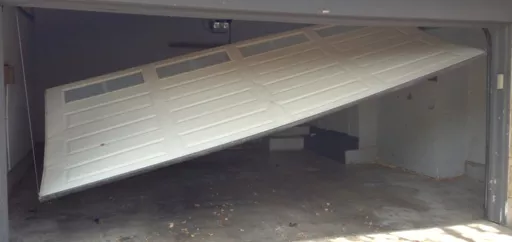
Your garage door isn’t working right and making strange noises. You wonder what the cause is and are ready to investigate. But, be warned! Here are 5 situations where you should never try to repair a broken or worn part as each is very risky and liable to cause serious injury.
Broken or stretched out springs
The basics:
- The spring system serves as a counterbalance to the weight of the door, regardless of its size or what it is made of.
- A garage door that is properly balanced by its spring system will weigh between 8 and 10 lb. (3.5 and 4.5 kilos). At this weight, it is easy to open with just one hand.
Why they can malfunction:
- The lifetime of torsion or extension springs is about 5 to 7 years, or around 10,000 to 12,000 cycles (a cycle = one open + one close).
- On average, a torsion spring loses 10% to 15% of its tension each year. There is no point in trying to crank the spring tighter to get more tension. A spring will break near the end of its life. If you hear a sound like a gun shot, there is a good chance it’s a broken spring.
- For extension springs, the cause is more often from the springs stretching. If there is a break, it more often happens at the end of the spring, in the loop. A stretched spring doesn’t give the same performance and as there are two springs, located over the horizontal tracks, the door will still open and close with some shaking, hence the strange noise.
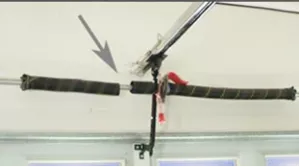
A broken TORSION spring
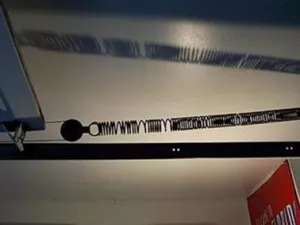
A stretched EXTENSION spring
Worn rollers
The basics:
- The quality of rollers on the market varies significantly. If they have ball bearings, more ball bearings means the roller will last longer.
- There are also black nylon rollers. They have no ball bearings. The cylinder that holds the rollers is galvanized and corrosion resistant.
- For double garage doors, it is advised to have long-stem rollers installed in double hinges.
Why they can malfunction:
- Many people forget that rollers must roll in the tracks and not slide.
- Breakage often happen on double doors that don’t have long-stem rollers and double hinges at the ends of a door.
- If the door stays open for long periods, and it is equipped with single rollers, the weight put on the rollers will make them wear out faster.
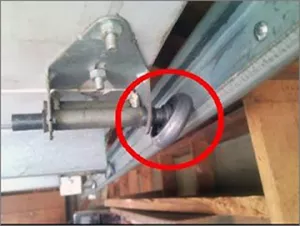
Worn-out roller
Broken, slack or frayed lifting cables
The basics:
- Lifting cables are the link between the bottom of the door and the spring system. They wind around a drum that features grooves for properly placing the cable.
- Because the lifting cables firmly attach the bottom section to the spring system, everything is under high tension. This tension corresponds to the total weight of the door. Trying to remove the lifting cable at the bottom of the door puts you at significant risk.
Why they can malfunction:
- If the drum is incorrectly positioned or misaligned, the cable will fray due to misalignment in the drum grooves.
- If the cable isn’t the right diameter for the size and weight of the door, it is at risk of breaking.
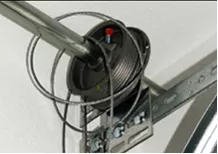
Broken lifting cable
Misaligned horizontal tracks
The basics:
- Horizontal tracks are attached to the ceiling with right-angle metal brackets.
- They should be solidly attached and screwed into a piece of wood (rafter).
Why they can malfunction:
- If the triangle forming the attachment point for the horizontal tracks wasn’t done properly, vibrations from the opening and closing of the door will cause the two tracks to become misaligned which could lead to the door falling.
- If this has happened, do not try to lift the door yourself. Leave everything in place and immediately call a garage door technician.

Misaligned horizontal tracks
Broken or stripped door opener gear and sprocket
The basics:
- Some garage door opener parts are made of plastic, such as the gear in the motor. This gear is made of rigid plastic but it can break if the drive chain puts too much pressure on it.
Why they can malfunction:
- A broken spring will cause the weight of a door to become unbalanced. Remember, a correctly balanced door weighs between 8 and 10 lb. (3.5 and 4.5 kilos).
- Some low-quality door openers are not made to lift heavy weights. If you hear a grinding sound coming from your door opener, like it is working hard, check that you don’t have a broken spring.
- If this happens, in order to open the door, pull down on the emergency cord to disengage the door opener and manually open the door.
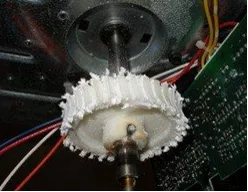
A door opener gear that needs to be replaced
A last piece of advice…
Always let a garage door professional take care of these types of repairs. It is not worth risking your safety. You can contact us anytime at 1-877-794-4223.
If you need to change your garage door, we can also visit you at home and explain the full range of garage door products on the market today. We can also send you a quotation by email. You can get an idea what your next garage door will look like by using our design center or by perusing our image gallery.









Comments
Garage doors repair
The real-life repair stories are a great addition to this post. It's reassuring to know that even challenging issues can be resolved with the right expertise.
Soo Overhead Doors Inc
Hi Joseph! Thank you for your feedback! We're glad you found the real-life repair stories valuable. Indeed, having the right expertise can make a significant difference in resolving challenging garage door issues safely and effectively. Your reassurance is appreciated!
Add new comment